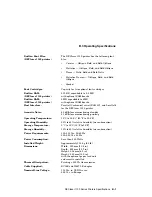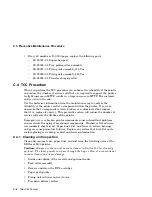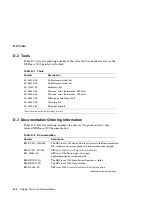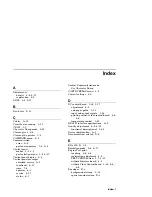
J
J101
location of, 10–8
Jam
areas; sensing; detection, 7–4
fixing and delivery FIP, 7–9
sensors (PS12 and PS13), 1–14
L
Labels, B–5
Laser safety information, xiv
LAYOUT menu, 2–9
LOAD<–ROM, setup procedure, 2–14
LocalTalk interface specifications, A–9
LVPSA, 1–22
CB101, 1–7, 1–22
fixing heater control, 1–22
location of J101, 10–20
safety switch, 1–9, 1–14
M
Macro feature, 2–7, 2–10, A–2
device identification, A–3
examples, A–4
initialization message, A–3
invoking, 2–3, 3–3
user preference character set, A–2
Maintenance, C–1
Menu
INTERFACE, 3–5
Menu descriptions, 3–5
Menus
COMMAND, 2–9
COPY/OVERLAY, 2–9
FONT/FEED, 2–8
INITIAL, 2–10
INTERFACE, 2–12
LAYOUT, 2–9
page format, 2–16
port selection, 2–4
port selection or Emulation, 2–17
scrolling, 2–3, 2–6
Menus (cont’d)
setup, 2–6
Tray size, 2–16
Miscellaneous menu, 3–21
O
Operating specifications, B–5
Operator call, 6–4
Option RAM
See
RAM option
Options
font cartridges, 1–3
PostScript cartridge, 2–1, 3–1
RAM memory, 1–7
Ozone, 1–1
P
Page (tray size) format menu, 2–16
Paint feature, 2–7, 2–10, 6–15
Paper handling, 3–19
Paper handling menu, 3–19
Paper paths, tray and feeder, 1–10
Parallel connector pin assignments, A–4
Parallel port or connector, 1–5
Part locations, 9–3
Part numbers, 9–1
PCL4 SETUP Menu, 3–13
Ports or connectors
See
Communication ports or connectors
PostScript option cartridge, 2–1, 3–1
Power up
jams, 7–5
SAVE–>NVRAM values, 2–14
PPL3, 2–17
Print media, B–1
envelopes, B–3
handling and storage of, B–1
labels, B–5
standard sizes of, B–2
transparencies, B–4
Printer configuration, 4–2
Index–3



































